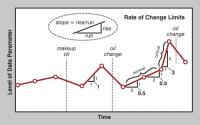 Add My Company
Add My Company
Sign In
What are rate of change alarms?
06-02-2019

Rate of change alarms differ from normal level alarms in that they respond to the change in a variable over a period of time, rather than the absolute value of the variable. See how these alarms work in greater detail.
How do rate of change alarms work?
Rate of change alarms differ from normal (level) alarms in that they respond to a specified rate of signal change rather than to the crossing of an absolute threshold in the measured variable.
For example:
a. Normal alarm is set to 850 degrees C.
When t 850°C an alarm is triggered
b. Rate of change alarm is set to 10 degrees C per minute
When the temperature changes from 820 to 835 degrees C over one minute, the alarm is triggered (because the temperature changed by 15 degrees per minute - greater than the 10 degree per minute alarm setting).
When temperature changes from 240 to 255 degrees over one minute, the alarm is also triggered.
When temperature changes from 930 to 935 degrees over one minute, the alarm is NOT triggered(the rate of change is only 5 degrees per minute).
We can see that these alarms only respond to changes, and ignore the actual measured value.
Rate-of-change Alarm setpoints can be positive (signal going UP) or negative (signal going DOWN). The alarm will only be triggered when the rate of change is greater than the rate set as the alarm threshold in the direction of the setpoint. For example if the rate alarm is set to -10 degrees C per minute, then the measured value must be falling at a rate greater than this for the alarm to be triggered.
NOTE:
Rate of change alarms will only be present while the measured variable is changing. Once the measured variable stops changing, then the alarm will reset.
The rate of change is normally measured over a given sampling period. The reading is effectively averaged over the period of sampling time so instantaneous (quick) changes will be detected but will be suppressed. The measurement can only indicate what the average change over time was. For instance, if a signal changes by 10 degrees in 10 seconds, then the actual rate of change is 60 degrees per minute, but only for that ten second period.
If the rate-of-change alarm is set to a one minute sampling rate, then the rate will be measured as a 10 degree change between the one minute samples (or 10 degrees per minute). If the alarm was set to 15 degrees per minute, then the rate alarm would not have been triggered.
Why are Rate of Change Alarms used?
They are used to predict an event that is behaving abnormally in order to take preventative action in order to avoid a failure. So if a change of process value suddenly increases at a rate beyond the normal, then it can indicate something unusual has changed in the process as shown.
For more information on What are rate of change alarms? talk to Omniflex UK Limited
Enquire Now
List your company on FindTheNeedle.

